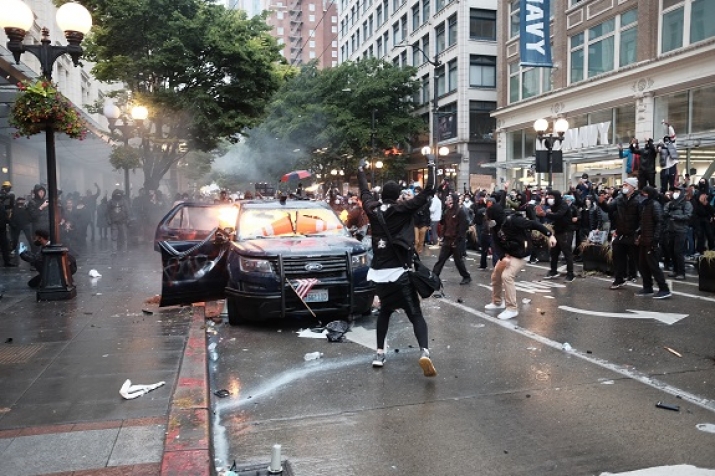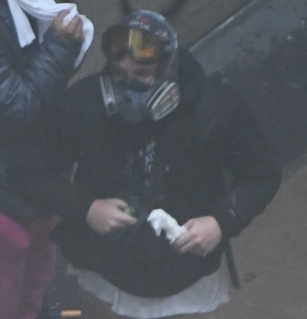A Washington man was sentenced to prison after he was convicted of hurling Molotov cocktails at Seattle Police Department vehicles during a violent demonstration following the death of George Floyd.
Kelly Thomas Jackson, 21, was handed a sentence of 40 months in prison and three years of supervised release for tossing the incendiary devices and burning two law enforcement vehicles on May 30 of last year in a downtown Seattle protest that devolved into a riot, the U.S. Attorney’s Office for the Western District of Washington announced on Monday.
Several videos reviewed by law enforcement showed a white male suspect, who was later identified as Jackson after an anonymous tip was submitted to law enforcement, tossing Molotov cocktails at police vehicles and “jumping up and down with excitement after his crime,” the statement added. Authorities reviewed the 21-year-old’s web history and determined he accessed “web-based information on how to construct Molotov cocktails.”
Jackson pleaded guilty on Jan. 6 to two counts of possession of a destructive device.

SEATTLE POLICE PRECINCT VANDALIZED SOON AFTER CITY REMOVES PROTECTIVE BARRICADE
Acting U.S. Attorney Tessa Gorman drew a distinction between Jackson’s conduct and the actions of the protesters, the “vast majority” of whom she said were peaceful.
“Unlike the vast majority of demonstrators who came to downtown Seattle to protest peacefully against systemic racism, this defendant came armed with Molotov cocktails [and was] intent on dangerous destruction,” Gorman said. “The danger to others is captured in pictures from the scene: flames from the burning cars and burning gasoline spread across the sidewalk, pollutant-filled smoke billowing into the crowd. This isn’t free speech. It is criminal conduct deserving of a federal prison sentence.”
Donald Voiret, FBI special agent in charge of the Seattle Field Office, said Jackson exploited the protest for the purpose of “destroy[ing] property and creat[ing] chaos.”
“This instigator researched his arsons and, on multiple occasions, endangered the safety of those nearby, as he helped to overshadow peaceful protests and escalate the environment into violence,” he added.

Seattle had several demonstrations after Floyd’s death last May, and the city gained increased national attention after an enclosed autonomous zone known as the “Capitol Hill Organized Protest,” or CHOP, formed on June 8. Two people died, including a juvenile, and four were shot during prolonged violence after protesters took over the Seattle Police Department’s East Precinct and erected a perimeter that kept out Seattle law enforcement. The occupied district persisted for weeks before officers disbanded it on July 1.
In late August, rioters were captured on video attempting to lock officers inside the department’s East Precinct and burn it to the ground. Their efforts were unsuccessful, but law enforcement said the group tried to cement the door shut and seal the officers inside.
“They mixed up the ‘Quikrete’ and then tried to seal off the exits,” Sgt. Randy Huserik said. “I don’t think there’s a lot of leaps that have to be made about what their intent was last night.”
CLICK HERE TO READ MORE FROM THE WASHINGTON EXAMINER
Floyd’s death while in police custody sparked nationwide protests throughout the summer of 2020. Derek Chauvin, the officer captured on video kneeling on Floyd’s neck during an arrest in Minneapolis, was charged with second-degree murder, third-degree murder, and second-degree manslaughter. His trial, which has inspired a new wave of demonstrations, began on Monday.
The Seattle Police Department did not immediately respond to a request for comment from the Washington Examiner.

